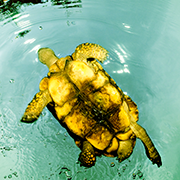The most powerful of the world’s river systems, its rapid transformation will alter the global climate. Emptying into the great Atlantic Ocean, it flows through the world’s largest tropical rainforest, the vast, natural theater where evolution has gone wild, creating the greatest biodiversity of any area on the planet.

Twenty-five years ago, Jean-Michel Cousteau explored this fabled region of enchanted rainforests with his father, the legendary Jacques Cousteau. Together they marveled at the extraordinary biodiversity and complexity of the world’s single largest tropical rainforest, home to unfathomable numbers of fish, birds, mammals, amphibians, reptiles, and invertebrates. Traversing the world’s longest river, the Amazon River contains the largest number of freshwater fish in the world, and accounts for over 15 percent of the world’s total freshwater discharge into the Atlantic Ocean.
An area spanning 6.7 million kilometers squared, nearly the size of the continental United States, the Amazon biome is a remarkable haven of biodiversity that supports 10 percent of the world’s known species and nearly half of the plants and animals on Earth. The respiring rainforests are responsible for producing 20 percent of oxygen we breathe, and in the process serve an invaluable role in removing carbon dioxide from the atmosphere, helping to alleviate the negative effects of human accelerated climate change from increasing carbon dioxide in the atmosphere.
Since Jean-Michel and his father visited, the Amazon has undergone widespread change. Now more than thirty million people call the Amazon home, relying on its vast resources for agriculture, clothing and traditional medicines. However, expanding human populations, poorly planned development and unsustainable resource extraction, such as gold mining, oil exploration and extraction, deforestation, and overharvesting of fish and other species threatens the future of the Amazon. In the last two decades alone, an area greater than the size of Spain has been deforested. Furthermore, the drive for hydropower from dams causes immense conflict between native residents and industries, and disrupts the natural river flows that sustain the Amazon’s fruitful water cycle and abundance of natural and human benefits.
Returning in 2008, Jean-Michel Cousteau and the Ocean Futures Society team traveled back to the Amazon for an intimate look at recent changes in Jean-Michel Cousteau’s: Ocean Adventures – Return to the Amazon. Combining science and discovery with expert story telling and astonishing footage, the team encountered the challenges and uplifting stories of the enchanted Amazon rainforests.
State of The Amazon
- The Amazon is threatened by unsustainable development, agricultural expansion, ranching, mining, oil extraction and logging practices leading to massive deforestation
- During the last 50 years the Amazon has already lost over 17 percent of its rainforest cover
- An area of rainforest equivalent to 36 football fields – continues to be lost every minute
- An estimated 15 percent of all greenhouse gas emissions are due to deforestation, illustrating the importance of the Amazon in regulating climate
- The world’s third largest damn, the Belo Monte on the Xingu river in the Amazon basin, is currently being constructed and when completed, will divert nearly the entire flow of the Xingu river, flooding an area of rainforest the size of Chicago, and reducing freshwater, fish, and other resources to natives downstream
 The Amazon Expedition Team |
 An Educator's Perspective |
 Videos from The Amazon |
Learn more about our work in the Amazon
- Watch our PBS documentary series Jean-Michel Cousteau’s Ocean Adventures - Return to the Amazon
- View our award-winning, interactive ebook, Return to the Amazon

Quick Facts
- Covering less than 2 percent of the Earth's total surface area, the world's rainforests are home to 50 percent of the Earth's plants and animals
- One-fifth of the world's fresh water is found in the Amazon Basin
- More than 2,000 tropical forest plants have been identified by scientists as having anti-cancer properties
- A warmer and drier climate in the Amazon from climate change is likely to cause a cascading effect that would convert 30-60 percent of productive Amazon rainforests into dry savannas in the coming decades
Support Ocean Futures Society!
We rely on your support to help us be a Voice for the Ocean. By becoming a member, donating, or taking part in our Action Alerts, you help us spread our message, “Protect the Ocean, and you protect yourself, and future generations to come.”
Exploration
Donate to Two Futures Society
Yes! I want to support the field work, projects and mission of Jean-Michel Cousteau and the OFS team. Make a tax-deductible donation now!
Become a Member
Yes! Sign me up for a free membership!

Connect With Us